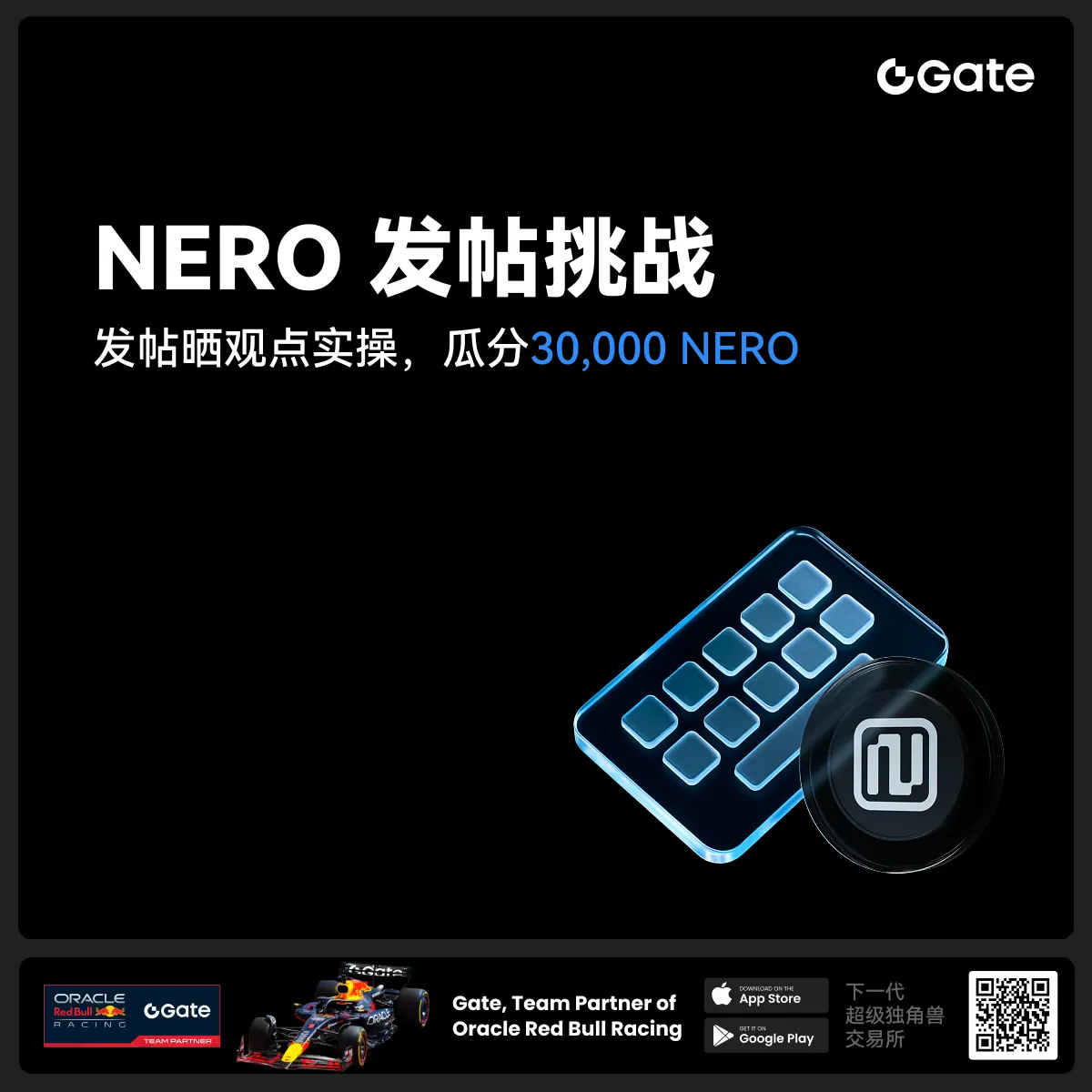- 话题1/3
37k 热度
26k 热度
43k 热度
8k 热度
21k 热度
- 置顶
- 🎉 #CandyDrop合约挑战# 正式开启!参与即可瓜分 6 BTC 豪华奖池!
📢 在 Gate 广场带话题发布你的合约体验
🎁 优质贴文用户瓜分$500 合约体验金券,20位名额等你上榜!
📅 活动时间:2025 年 8 月 1 日 15:00 - 8 月 15 日 19:00 (UTC+8)
👉 活动链接:https://www.gate.com/candy-drop/detail/BTC-98
敢合约,敢盈利
- 🎉 攒成长值,抽华为Mate三折叠!广场第 1️⃣ 2️⃣ 期夏季成长值抽奖大狂欢开启!
总奖池超 $10,000+,华为Mate三折叠手机、F1红牛赛车模型、Gate限量周边、热门代币等你来抽!
立即抽奖 👉 https://www.gate.com/activities/pointprize?now_period=12
如何快速赚成长值?
1️⃣ 进入【广场】,点击头像旁标识进入【社区中心】
2️⃣ 完成发帖、评论、点赞、发言等日常任务,成长值拿不停
100%有奖,抽到赚到,大奖等你抱走,赶紧试试手气!
截止于 8月9日 24:00 (UTC+8)
详情: https://www.gate.com/announcements/article/46384
#成长值抽奖12期开启#
- 📢 Gate广场 #NERO发帖挑战# 秀观点赢大奖活动火热开启!
Gate NERO生态周来袭!发帖秀出NERO项目洞察和活动实用攻略,瓜分30,000NERO!
💰️ 15位优质发帖用户 * 2,000枚NERO每人
如何参与:
1️⃣ 调研NERO项目
对NERO的基本面、社区治理、发展目标、代币经济模型等方面进行研究,分享你对项目的深度研究。
2️⃣ 参与并分享真实体验
参与NERO生态周相关活动,并晒出你的参与截图、收益图或实用教程。可以是收益展示、简明易懂的新手攻略、小窍门,也可以是行情点位分析,内容详实优先。
3️⃣ 鼓励带新互动
如果你的帖子吸引到他人参与活动,或者有好友评论“已参与/已交易”,将大幅提升你的获奖概率!
NERO热门活动(帖文需附以下活动链接):
NERO Chain (NERO) 生态周:Gate 已上线 NERO 现货交易,为回馈平台用户,HODLer Airdrop、Launchpool、CandyDrop、余币宝已上线 NERO,邀您体验。参与攻略见公告:https://www.gate.com/announcements/article/46284
高质量帖子Tips:
教程越详细、图片越直观、互动量越高,获奖几率越大!
市场见解独到、真实参与经历、有带新互动者,评选将优先考虑。
帖子需原创,字数不少于250字,且需获得至少3条有效互动
- 🎉 亲爱的广场小伙伴们,福利不停,精彩不断!目前广场上这些热门发帖赢奖活动火热进行中,发帖越多,奖励越多,快来GET你的专属好礼吧!🚀
1️⃣ #GateLaunchpad上线IKA# |IKA认购体验
在Gate广场带话题晒出你的IKA Launchpad认购体验,4位幸运分享者讲瓜分$200分享奖池!
详情 👉️ https://www.gate.com/post/status/12566958
2️⃣ #ETH冲击4800# |行情分析预测
大胆发帖预测ETH走势,展示你的市场洞察力!10位幸运用户将平分0.1 ETH 奖励!
详情 👉️ https://www.gate.com/post/status/12322403
3️⃣ #创作者活动第二期# |ZKWASM话题
在广场或推特发布与 ZKWASM 或其交易活动相关的原创内容,瓜分4,000枚ZKWASM!
详情 👉️ https://www.gate.com/post/status/12525794
4️⃣ #Gate广场征文活动第二期# |ERA话题
谈谈你对ERA的观点/体验,参与并推广活动,700 ERA大奖等你赢!
详情 👉️ https://www.gate.com/post/status/12361653
5️⃣ #MBG任务挑战# |MBG话题
分享你对MBG的洞察,积极参与和推广MBG活动,20位小 - 🎉Gate 2025 上半年社区盛典:内容达人评选投票火热进行中 🎉
🏆 谁将成为前十位 #Gate广场# 内容达人?
投票现已开启,选出你的心头好
🎁赢取 iPhone 16 Pro Max、限量周边等好礼!
📅投票截止:8 月 15 日 10:00(UTC+8)
立即投票: https://www.gate.com/activities/community-vote
活动详情: https://www.gate.com/announcements/article/45974
Bitcoin’s quantum threat: Naoris offers bounty to break crypto encryption
Naoris, a cybersecurity firm focused on safeguarding digital assets from quantum computing threats, is offering bounties to anyone who can break the encryption algorithms that secure major blockchain networks.
In an announcement shared with Cointelegraph on Thursday, Naoris said it has set a bounty of $120,000 — equivalent to approximately one Bitcoin (BTC) — for successfully compromising key cryptographic algorithms used in the crypto industry.
The largest bounty, $50,000, is for anyone who can break secp256k1, the cryptographic standard that underpins Bitcoin, Ethereum and many other protocols. A $30,000 reward is available for breaking Ed25519, which is used by Solana, as well as encrypted messaging services like Signal and WhatsApp.
Naoris is also offering $20,000 for a successful attack on NIST P-256, the elliptic curve used in the Transport Layer Security (TLS) protocol, which secures internet traffic. Another $10,000 is set aside for breaking other elliptic curves, including P-224, P-384 and P-521.
What would happen if cryptography broke?
The bounties are set for breaking elliptic curve parameters, which are values or sets of values that define a specific elliptic curve used in cryptography, thereby determining the security and functionality of the cryptographic system.
Related: Quantum computers could bring lost Bitcoin back to life: Here’s how
The modern world heavily relies on cryptography, and the consequences of its being compromised would be dire and far-reaching.
A successful attack on Ed25519 would compromise the OpenSSH protocol used for secure server access, disrupt Git version control systems and threaten portions of the DNS security layer.
NIST P-224 is mostly used in legacy systems, such as old smartcards, and is set to be deprecated after 2030 by the US National Institute of Standards and Technology. It is about 30,000 times easier to break than 256-bit curves such as secp256k1.
Related: Bitcoin’s quantum countdown has already begun, Naoris CEO says
The quantum sword of Damocles hangs above Bitcoin’s head
While quantum computers are unlikely to break modern cryptography anytime soon, many experts believe that it is a question of when rather than if. Consequently, despite quantum computers being estimated to need tens of millions of qubits to break those systems, the crypto community has started preparing.
Bitcoin, in particular, is taking its first steps. A new Bitcoin Improvement Proposal (BIP) introduced this month aims to tackle the threat posed by quantum computers by phasing out Bitcoin’s legacy signature schemes.
“A successful quantum attack on Bitcoin would result in significant economic disruption and damage across the entire ecosystem,” the proposal reads. “Beyond its impact on price, the ability of miners to provide network security may be significantly impacted.”
During a mid-April interview with Cointelegraph, early cypherpunk Adam Back, cited by Satoshi Nakamoto in the Bitcoin white paper, suggested that quantum computing pressure may reveal whether the blockchain’s pseudonymous creator is alive.
He explained that quantum computing could make the Bitcoin held by Satoshi Nakamoto vulnerable to being stolen, forcing him to move it to preserve it.
Researchers are also looking for more blockchain-agnostic solutions. Earlier this week, Sui Research introduced a cryptographic framework that could provide protection against quantum computing threats to multiple blockchains without requiring hard forks, address changes or key updates.
Still, while that particular solution boasts compatibility with all EdDSA-based blockchains, this requirement excludes Bitcoin and Ethereum. Compatible blockchains include Sui, Solana, Near and Cosmos.
Magazine: Bitcoin vs. the quantum computer threat: Timeline and solutions (2025–2035)